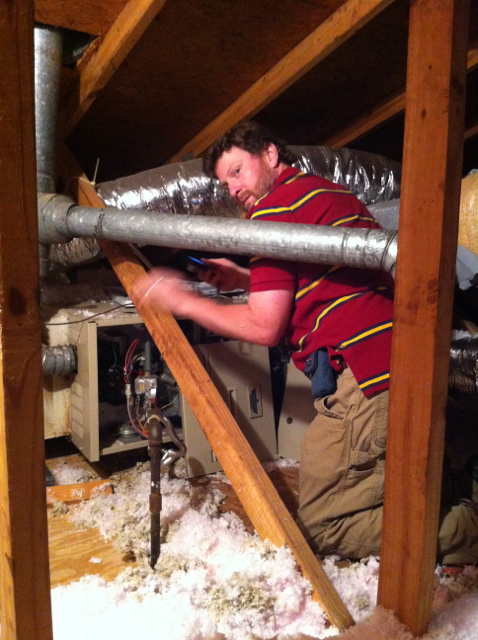
Image Credit: Energy Vanguard
Image Credit: Energy Vanguard The HERS Index scale, showing the reference point at 100 and a net-zero energy home at 0.
Image Credit: RESNET The HERS Index equation, straight from the HERS Standards. Not very attractive or intelligible, but if you know how to interpret it, all the information is there.
Image Credit: RESNET The HERS Index equation, simplified from the HERS Standards. If you're not an engineer and don't need to know that nMEUL stands for normalized modified end use loads — and what that actually means — then this version should serve your purposes.
Image Credit: Energy Vanguard The Purchased Energy fraction equation for the HERS Index, simplified
Image Credit: Energy Vanguard
A lot of home builders and homeowners are getting certified home energy ratings to find out how efficient their homes are. There’s also a lot of buzz about HERS ratings, with builders looking at them as a tool for marketing their homes. The rating process models the energy performance of a home and comes up with, among other results, a number called the HERS Index. But what exactly is this thing called the HERS Index?
We could approach that question a lot of different ways. My objective here is to focus on the mechanics — how the HERS Index is defined and how it’s calculated. For greater depth on the mechanics or more on HERS ratings in the broader context, see the links at the end of this article.
The basics
Here are the fundamental ideas behind the HERS Index:
- It’s a linear scale, with 100 meaning the rated home has the same energy use as the HERS Reference Home.
- The HERS Reference Home is based on definitions in the HERS Standards, with some specifications based on the 2004/2006 International Energy Conservation Code (IECC).
- The HERS Index includes the energy consumption from heating, cooling, water heating, lights, and some appliances.
- Each one-point change on the HERS Index scale represents a 1% change in energy efficiency.
- A HERS Index of 0 means the home has net zero energy use. That is, the home produces as much energy as it uses.
The second image below shows the scale for a home with a HERS Index of 65, which would be 35% more efficient than the Reference Home.
The HERS Index equation
If the basic info above isn’t sufficient for you, the HERS Standards would be the ultimate place to go for more details. That’s where the whole process is defined. For example, if you wanted to see the actual equation used to calculate the HERS Index, you could go to page 3-4 in chapter 3. To save you the effort, I’ve pasted a copy of the equation directly from the HERS Standards below (third image).
Yes, it’s ugly, ugly, ugly! You could spend a while sorting through all the horribly-named variables, but, since you’re reading this article, you can skip right over that bit of ugliness above (have I mentioned how ugly it is?!) and get the idea behind it from my simplified version of the equation, shown right after RESNET’s version (fourth image).
Much better, right? The E stands for energy consumption, WH stands for water heating, and LA stands for lights & (some) appliances. PEfrac needs a separate explanation, which I’ll give you shortly. To be fair, though, there’s still a lot hidden in both versions of the equation you see above. Calculating those four individual components (heating, cooling, water heating, and lights & appliances) involves a whole lot of definitions, specifications, assumptions, and yet more equations. Chapter 3 of the HERS Standards, which contains the technical standards for HERS ratings, is 44 pages long and is constantly being updated, revised, and amended.
The HERS Index equation basically compares the energy use of the rated home to the energy use of the HERS Reference Home. If the total of those four components is the same for both the rated and Reference homes, the fraction part of the equation equals 1. Then you multiply it by 100 to get a HERS Index of 100 in that case (assuming PEfrac = 1 for now). If the rated home’s energy use is half of the Reference Home’s energy use, the HERS Index would be 50. If the rated home uses twice as much as the Reference Home, the Index would be 200.
Now, what about the PEfrac part? First, the PE stands for ‘Purchased Energy,’ so that gives you some idea of what it does. It’s a multiplier that can reduce the HERS Index for homes that produce some or all of the energy they use over the course of a year. You can see the equation for PEfrac in the fifth image below, again simplified from the HERS Standards to make it more understandable.
If a home has no on-site power production (Eproduced = 0), the fraction is just 1 and it has no effect on the HERS Index. If the rated home produces an amount of energy equal to half of what it uses (Eproduced = 0.5 x Eused), PEfrac = 0.5 and it cuts the HERS Index in half. If the rated home produces the same amount of energy over the course of a year as it uses (Eproduced = Eused), PEfrac = 0 and the HERS Index is also 0. That is, it would be a net-zero energy home. If the home produces more energy than it uses (Eproduced > Eused), PEfrac will be negative, and so will the HERS Index.
The HERS Reference Home
One aspect of the HERS Index that bears further scrutiny is the HERS Reference Home. Here’s what the HERS Standards say about it:
“The reference home is the geometric twin of the rated home, configured to a standard set of thermal performance characteristics, from which the energy budget, that is the basis for comparison, is derived.”
Basically, the Reference Home is the same size and shape as the rated home and is also in the same location and IECC climate zone. The inputs for insulation R-values, window U-values, HVAC system efficiency, and similar factors are defined in the HERS Standards but are close to what’s in the 2006 IECC.
Let me point out a couple of important points about the Reference Home. First, some aspects vary with climate zone, and some are fixed. For example, wall insulation R-values change with location but the window area in the Reference home is always 18% of the conditioned floor area and is spread out equally on south, east, north, and west facing walls. Second, the Reference Home doesn’t have everything that the rated home has. Although a rated home may have photovoltaic modules, for example, the Reference Home will not.
The really important thing to know about the HERS Reference Home is that it’s your reference point, hence the name. Yes, the energy code that it’s based on has advanced, but we don’t want to go changing our reference because if we did that, the scale would change. That would be like changing the definition of the mile just because our modes of transport got faster.
Likewise, the HERS rater industry in Canada is just getting going and could adopt a different HERS Reference Home. If they want to be able to compare their homes’ HERS Indices to ours in the US, however, they need to keep the same definition of the HERS Reference Home. Otherwise it’s apples and oranges, and CRESNET’s Cross-Border Challenge would be difficult to judge.
Summary
That’s it. A HERS Index is a number that compares how a given home’s energy use to a reference point, which is the HERS Reference Home. Numerically, it’s like golf scores – the lower the number, the better. I’ve seen scores above 200 for really bad houses and a low score of -2 for a net-zero energy home in Tennessee.
The equations above show how to calculate it. As they always say, though, the devil’s in the details, so if your intention is to write software to be used as an accredited HERS rating tool, you’ll need to spend a lot of time poring over the HERS Standards. If you’re just looking for the overview with some detail about what goes into calculating a HERS Index, I hope this article gave you what you needed. If not, check out the links below or leave a comment here.
Resources
The ultimate source of info about the HERS Index is the 2006 National Mortgage Industry Home Energy Rating System Standards (pdf).
Last year, Martin Holladay wrote about the HERS Index in his Musings of an Energy Nerd column here at Green Building Advisor but looked at it from a different angle: How Is a Home’s HERS Index Calculated?
Martin also wrote a thorough article on energy modeling in general that you might want to check out: Energy Modeling Isn’t Very Accurate.
RESNET has been pushing hard for builders to adopt the HERS Index as a marketing tool, and I wrote about that a while back: ENERGY STAR Version 3 vs. the HERS Index.
Finally, one thing that many people don’t seem to understand is that a HERS rating is just an analysis tool. It’s not a certification program for homes with guidelines and thresholds: A Home Energy Rating Is Not an Award.
Allison Bailes of Decatur, Georgia, is a RESNET-accredited energy consultant, trainer, and the author of the Energy Vanguard blog.
Weekly Newsletter
Get building science and energy efficiency advice, plus special offers, in your inbox.





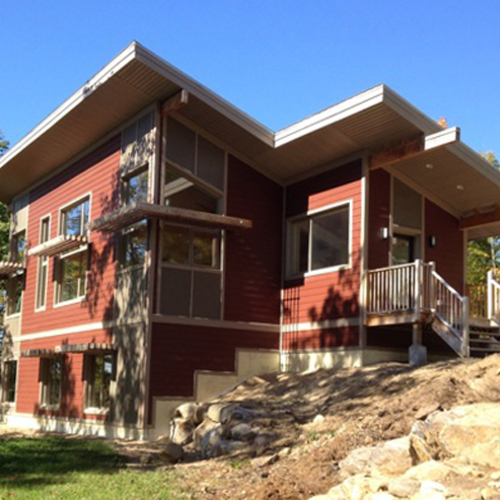
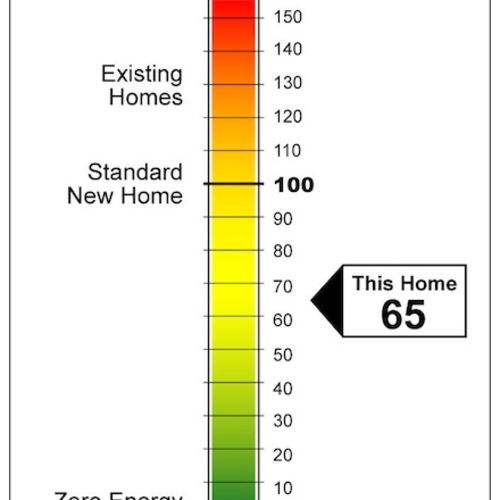
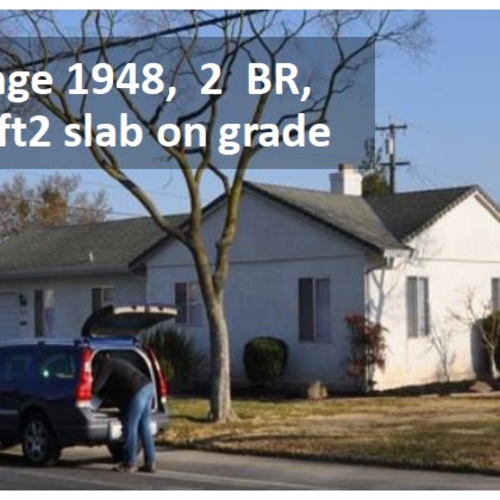
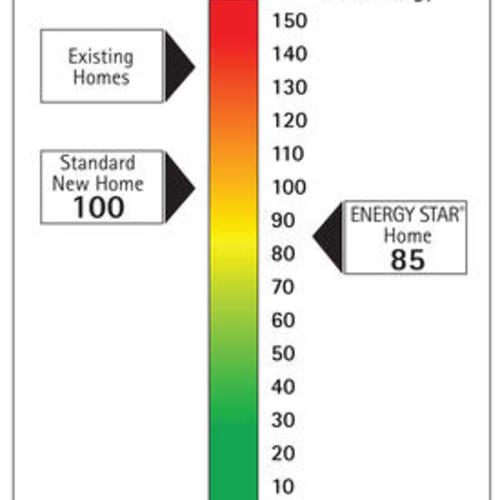






9 Comments
Reference Home Glazing Area
Allison,
I bookmarked this "revision" a while back
http://www.energystar.gov/ia/partners/bldrs_lenders_raters/downloads/V3HERS_IndexTargetProcedure.pdf
I thought the glazing area for the reference home was/is changing to 15% ??
Response to John Brooks
As soon as I found out about the new ENERGY STAR Reference Design (ESRD), I knew that it would cause exactly this kind of confusion. I didn't mention it in the article, John, but your comment refers to a different reference home, the one that ENERGY STAR uses in Version 3 of the new homes program to calculate the variable HERS Index target. The ESRD is a list of specifications that the rating software uses to calculate what HERS Index a home needs to qualify for ES V3.
The HERS Reference Home still uses 18% for the window area, and that hasn't changed. See page 3-12 in the HERS Standards.
TEU for windpower
Allison,
Thanks for the very helpful and informative article.
Question: I purchase 100% (certified RECs) wind power. Since a wind turbine is not a "heat engine," wind power's Reference Electric Production Efficiency has to be much higher than 40%.
Do you know the efficiency rating for wind power in the RESNET standard?
Agree, but...
As the building industry and municipalities depend more and more on certified home energy raters, we need to understand that education, experience and integrity of raters is of first priority, just like any other profession. A large majority of raters work with the highest degree of professionalism; however, the sad part about it is that it’s been sold as the ultimate in verification, and often enough, I see suspect ratings and even worse verifications. The following are pictures from a “verified” house I visited a while back; it received its “certification”.
Great photos, Armando
Armando,
Thanks for the sobering photos, Armando, and the important reminder.
Rating definitely could be by
Rating definitely could be by eyeball;
A-Great
B-Good
C-OK
D-Poor
F-Fail
with "+ or -" as a modifier.
A-F could be assessed in minutes. Then with inspecting top to bottom and doing some actual improvements with a blower door onsite, one could write up a pretty complete list of do's and future to do's.
Not sure the HERS massive calculation is worth the time for all homes. But it is very interesting to see that we are trying to scientifically approach energy improvements of our homes and buildings. Use it on samples of typical homes, and of course the Docs (Allison, John S, Joe L's) should use it and share with us all their findings.
One thing I know is all the main government mandated software should be open source and fully avalable to all along with all government building codes. Downloadable and fully searchable and fully explained with complete help and examples. BSC is paid very well by the tax payers. Get this all online, free, and used.
Open Office, great product
Wiki's great, even though lots of you poo poo Wikipedia
We live on one big blue and green ball. We are one community now that Columbus was followed by all the stragglers. We need somethings to be shared freely for the good of all of us. I love capitalism if kept and eye on and as to all our building regs, they are ours, they are for all of our benefit and they should be just a click away.
Barriers to HERS
Armando, some of your pictures seem to show lack of proper air barriers, which as you know would be duly noted as part of a thermal bypass inspection. Energy Star inspections and verifications would presumably catch that, but it is not a requirement of RESNET. Yes, the HERS inspector could grade it as a #3 for installation of insulation, which good ones will do when lack of air barriers are noted, but not always. And one can still get a HERS index with a #3 rating of the insulation, albeit with a slightly diminished index score.
We understand RESNET and EPA are in discussion on how to incorporate TB inspections and air barrier verification as part of a HERS inspection, which if it happens will clearly add credibility to a HERS rating, but that hasn't happened yet. In markets with inspectors dually certified for ES and RESNET, TB inspections would be a simple add-on. In markets with 5-day trained HERS raters with no building science background, it is a recipe for disaster.
If RESNET does incorporate new protocols they will need to train and test all their HERS raters on the often counterintuitive process of proper air barrier alignment. I highly recommend Armando Cobo for such training...
Response to William Rau
If you're not generating the power onsite, it doesn't affect the HERS Index. The equation for the PEfrac multiplier includes only energy generated onsite to reduce the HERS Index. If you had a wind turbine at your home, then you could take credit for it in the HERS Index, but it would just count the amount of energy produced, which you'd be metering at the home. REM/Rate, the HERS software we use, doesn't include wind power, though, because so few homes have it, and I don't know exactly how it would be put into the software.
Response to Kim Shanahan
I haven't heard of the RESNET/EPA discussions, but RESNET can include those requirements anytime they want. I'm not sure why they'd need to talk to the EPA about it. Since HERS ratings apply to both new and existing homes, though, it can't be a general requirement because you can't do that for existing homes.
You mentioned HERS raters with no building science background and only a 5 day training class. I've written quite a bit about this issue, and one way we combat that is to teach our HERS rater class in 8 days rather than 5. I also write a lot in the Energy Vanguard Blog and here and encourage raters to keep learning. A few months ago, I wrote an article called A Home Energy Rater Class Is Just the Beginning about ways that HERS raters (and others) can learn more after their all-too-short training class. Even our 8 day class isn't enough because there's just so much to learn. That applies to most of the people who go through these classes, too, because most people come into this without a building science background.
Log in or create an account to post a comment.
Sign up Log in